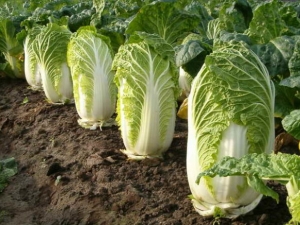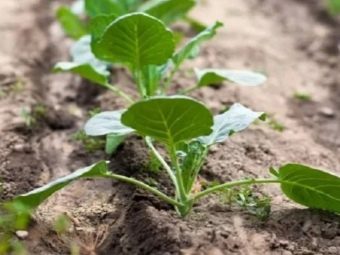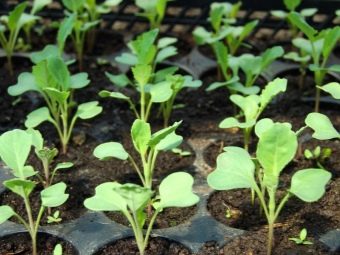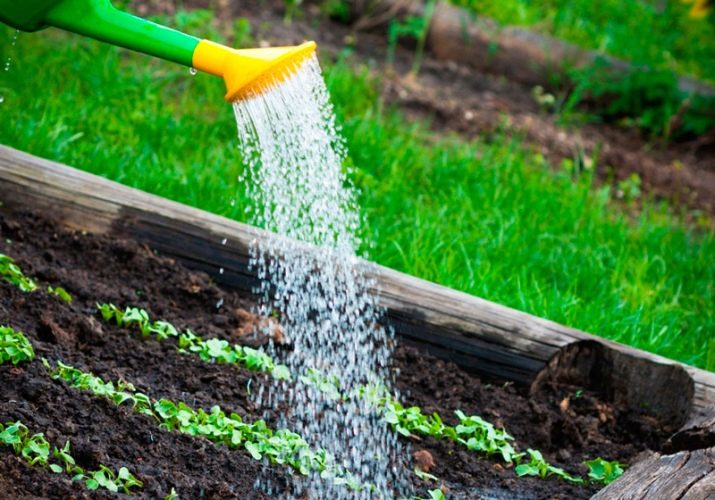When and how to sow Peking cabbage for seedlings?

Beijing cabbage has been used in cooking for quite some time.This tasty and delicate plant incorporates many vitamins and minerals. It is useful to use in diabetes, atherosclerosis, gastritis, ulcers, migraines and other diseases. It is recommended to use this product in the spring periods to raise the immunity.
Features of culture
Today, many gardeners began to plant this culture on their land plots. However, you need to know how to plant it, grow it and care for it in order to get a really high-quality product. It is also recommended to know in what soil the seedlings are planted. Because of this, cabbage may differ in its taste.
For the first time, Beijing cabbage was bred in China about 4,000 years ago. Currently, the product is used in cooking in many countries. Cabbage is added to roast, stewed separately, the soup is boiled out of it, consumed raw.
Beijing cabbage is an annual frost-resistant vegetable crop, which in 2 months from ordinary seedlings can stretch into a real vegetable, ready to eat. When the cabbage grows, it can have a loose, dense or short-headed (depending on the particular variety).
The length of the leaf, on average, is 25 cm, the color of the leaves is mostly green, but may vary in shades (depending on growing conditions). Vegetable is grown on all types of open ground.
Every vegetable gardener can sow such a vegetable, regardless of his experience in this case. Growing culture fast enough. With the right care for the season, you can harvest two crops. Beijing cabbage has a pleasant taste and healthy properties, and it is also quite easy to store.
Seed and Soil Preparation
When planting this culture, we must bear in mind that she loves heat and light. If these factors are not enough, then the head will not be able to fully form. In the presence of sun and light, it is possible to harvest from this crop twice a year.
The cultivation of Chinese cabbage can occur in a seedless or transplanting way. The second option is preferable, as it shortens the ripening period. To get an early harvest, the seeds must be planted in March.
The best would be the use of peat pots for planting. Vegetable loves loose soil, so it is better to add a little humus or another substrate to the soil (you can also use peat and turf). Seeds are located in the soil at a depth of 1 cm.
Watering is made infrequently, but only when the soil dries. Water should be three or four days, after which the procedure is terminated. When the leaves begin to form on the plant (and this will happen in about 30 days), the cabbage is ready for planting on the garden bed.
It must be remembered that Peking cabbage does not like picks: during this process, it can be injured. When the seeds appear first roots, the upper leaves (the weakest) must be pinch off.
So you can help the plant to remove unwanted parts, which will improve overall growth and development.
Before direct transplanting, it is required to carry it out over the course of 10 days (for 1-2 hours). In this way she will be tempered. Also, before planting, seeds and soil should be poured abundantly with water. After planting, the first shoots appear in 20-30 days. The optimal soil for planting is the site where potatoes or cucumbers were previously grown.
Seedling
For cabbage, it is necessary to choose the sunny part of the vegetable garden, on which other crops used to grow. First you need to make holes in the soil. The distance between them is 25-30 cm. Compost and humus are added to the well in small quantities. Then the seedlings are planted.
It is up to each gardener to decide which way of planting cabbage should be chosen individually (it is necessary to take into account the conditions where the plant will grow: in a greenhouse, on a bed or on open ground, and also in the season). It is worth remembering that in dry weather or in too hot weather, cabbages cannot form.If in the region where the cabbage is grown, it is too cold, then the plant will produce arrows and wilt.
How to plant?
Cabbage seeds in the soil is recommended to plant after it is heated. This usually happens in May. To get a second crop, seedlings can be planted again in early July. Pre-soak the seeds is not required. Sowing rate is 4 grams per 10 square meters. When sowing, seeds should be buried 10-15 mm into the soil. To do this, you can make holes with your fingers.
If planting will be done by seedlings, then it should be planted in the first days of May. Plants should be planted at a distance of, on average, 40 cm from each other. During the work it is necessary to ensure that the root system is not damaged. Therefore, it is recommended to use pots or other devices in which the plant can form its roots without damage.
To maximize the harvest, it is necessary to monitor the time intervals between the landing: it is imperative to plant seedlings in the spring (and not closer to the fall). In this case, the soil is also recommended to feed.
First harvest
With proper planting, the harvest can be obtained in a month. Sowing dates do not have exact dates: it all depends on the region and climate. Experienced gardeners recommend planting before the beginning of April in the southern regions, in the middle zone this should be done after April 20, and in Siberia it is better to plant it in early May.
It is also important to take into account the quality of the soil in which the seedlings will be planted, as well as the type of vegetable. To Beijing cabbage got accustomed in adverse climates, it is recommended to use resistant varieties. They are called hybrid.
How to grow?
This vegetable, like any other, loves meticulous care. Proper home care for Chinese cabbage includes feeding, weeding and watering. In order to get an optimum yield, it is important to grow with a balance between air temperature and humidity. Acceptable air temperature for growing cabbage should be within 17-18 degrees during the day, and at night should not fall below 8 degrees. Humidity can be within 80%.
If these recommendations are followed, the plant will grow quickly. Also, cabbage will not be prone to diseases in which the formation of a head does not occur.
Preference for planting should be given to fertile soil, in which there is a lot of nitrogen and calcium. The plant responds well to various dressings and complex fertilizers.
It is worth remembering that Peking cabbage can accumulate in itself nitrates, therefore, it is not recommended to use them for top dressing during the vegetative period.
Such fertilizer can be applied only at the moment when the seedlings will be planted on the site.
In dry weather, watering is done every day. Thus, the plant will receive the right amount of moisture and grow rapidly.
Features of cultivation: dressing
Depending on the time of transplanting, plants are fed in the open field. Fertilizers are best applied in dissolved form. For this you can use water with other components. Nitroammophoska or other similar substances are used as fertilizers.
For example, you can use a mullein solution. It must be diluted in water in a ratio of 1:10 and insisted a couple of days. Next, the tool is poured on the soil in the amount of 2 liters per 1 square meter.
To make cabbage better formed and not subject to disease, you can use boric acid infusion for watering. To do this, take one and a half grams of acid and dissolve it in 10 liters of water. The solution is infused for a day, after which the plant and the soil are treated with a spray gun.
Every year, about 5 kilograms of manure per square meter must be applied to the soil on which the cabbage will be grown. It can be mixed with superphosphate and potassium. This will improve the growth of the plant, as well as protect it from various diseases.
Before planting, it is important to add to the soil a solution that is prepared from bird droppings.
To do this, in a bucket of water must be diluted with 200 g of bird droppings. You can also use egg shells, which need to insist on water for two days before. If for some reason it is not possible to fertilize the soil in autumn, then this should be done 3 weeks before planting the vegetable. Next, the soil should be dig and fluff, sprinkle with saltpeter on top (at the rate of one tablespoon per square meter).
Pests and control of them
According to gardeners, the most common pests against Chinese cabbage are slugs and fleas. Due to the fact that it is the cabbage leaves that are used for food, it is not recommended to remove these pests with chemical solutions. To get rid of them, follow the simple instructions:
- observe crop rotation;
- observe the landing time;
- use shelters;
- apply ashes for processing.
Sometimes from the pests can help joint planting of cabbage and other crops, such as garlic, cucumbers, tomatoes or onions. Chemicals can be used only as a last resort (not earlier than 20 days before harvesting). In addition, these drugs should be used in accordance with the instructions.
Slugs are displayed in different ways. The most common of these is the use of slate, plastic or roofing material, which are placed near the cabbage planting place. In such places, the slugs will seek shelter for the night. The owner of the site should simply collect them every morning from the items described above.
In order to prevent parasites and diseases from spreading through cabbage, it is recommended to clean the beds of weeds. This should be done as they appear. After nitrate treatment, the cabbage surface should be examined for the presence of eggs of pests that may be under the leaves. If the eggs of the pests are identified, then they should be destroyed. This will help prevent their growth and development, respectively; later, cabbages will not need to be treated with chemical means.
Storage and cleaning
Beijing cabbage can withstand frost down to minus 3 degrees. At this time, it will grow and develop. Due to this property of the plant, it is possible to collect 2 crops of a vegetable per season. Cabbage can be harvested in any weather, focusing on its condition. Heads cut off. Long store cabbage is not recommended. It should be consumed fresh or processed (for example, to ferment).
The optimal storage conditions for cabbage heads are 6 degrees Celsius with an air humidity of 80%. You can also wrap cabbage in film and store in the refrigerator or freezer. So it can be stored for quite some time.
Gardeners tips
When growing cabbage is recommended to observe some rules. The main one is the shelter of the heads (after their formation) with non-woven material. It will help protect the plants from frost, will not allow overcooling at night, and during the day will protect from the sun and pests. It will also help speed up the heading process. Plants do not need spudding and cover with straw or peat.
On the secrets of growing Peking cabbage, see below.












































